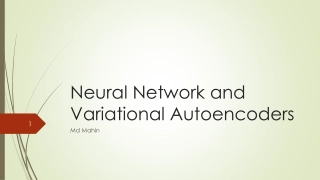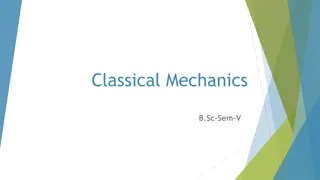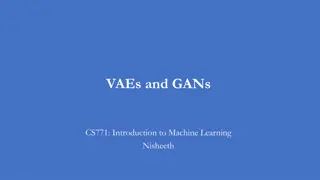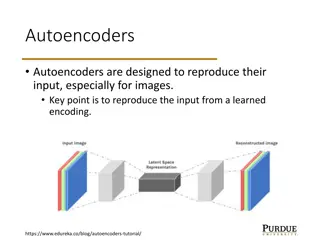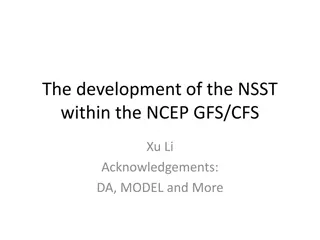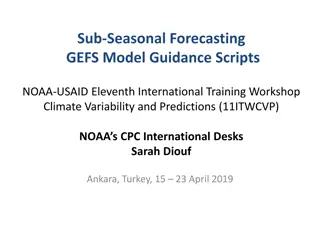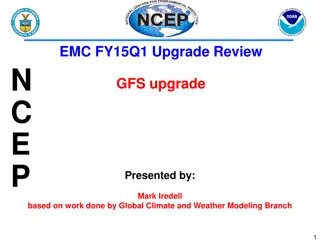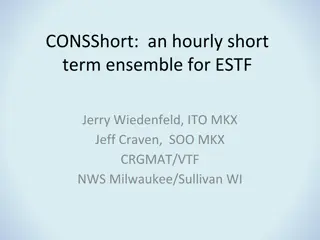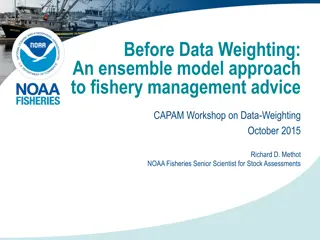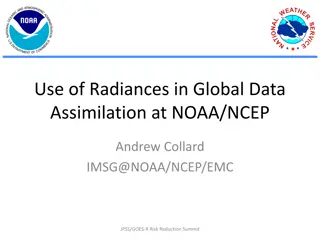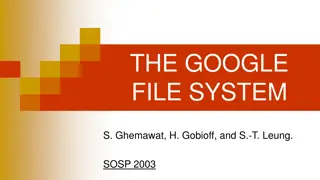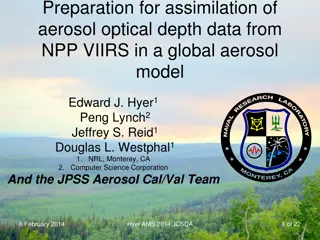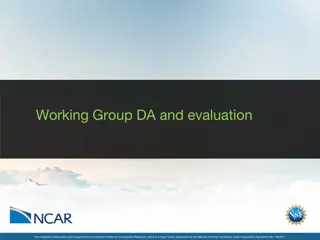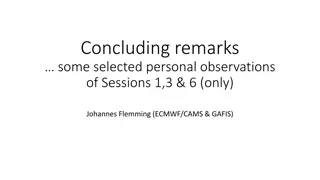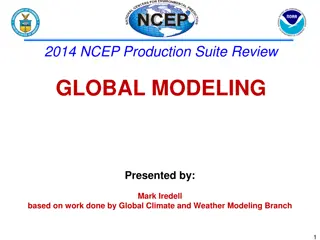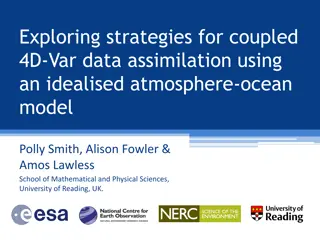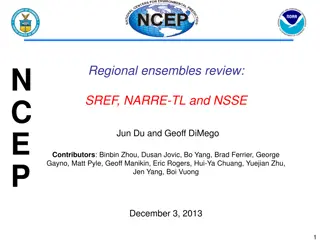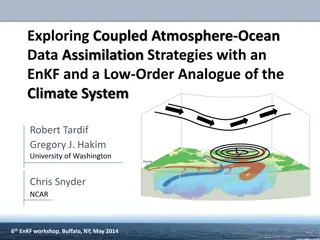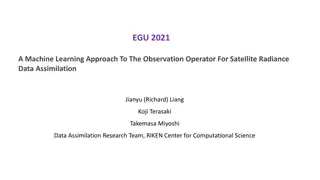Hybrid Variational/Ensemble Data Assimilation for NCEP GFS
Hybrid Variational/Ensemble Data Assimilation combines features from the Ensemble Kalman Filter and Variational assimilation methods to improve the NCEP Global Forecast System. It incorporates ensemble perturbations into the variational cost function, leading to more accurate forecasts. The approach offers advantages like better error handling, localization in model space, and flexible treatment of model errors. Ensemble generation methods like GEFS and EnKF play a crucial role in enhancing forecast accuracy without significant additional computational costs.
Download Presentation

Please find below an Image/Link to download the presentation.
The content on the website is provided AS IS for your information and personal use only. It may not be sold, licensed, or shared on other websites without obtaining consent from the author. Download presentation by click this link. If you encounter any issues during the download, it is possible that the publisher has removed the file from their server.
E N D
Presentation Transcript
Hybrid Variational/Ensemble Data Assimilation for the NCEP GFS Tom Hamill, for Jeff Whitaker NOAA Earth System Research Lab, Boulder, CO, USA jeffrey.s.whitaker@noaa.gov Daryl Kleist, Dave Parrish and John Derber National Centers for Environmental Prediction, Camp Springs, MD, USA Xuguang Wang University of Oklahoma, Norman, OK, USA 1
Hybrid: best of both worlds? Features from EnKF Features from VAR Extra flow-dependence in B Localization done correctly (in model space) More flexible treatment of model error Reduction in sampling error in time-lagged covariances. Automatic initialization of ensemble Ease of adding extra constraints to cost function
NCEP GSI 3D-Var Hybrid Incorporate ensemble perturbations directly into variational cost function through extended control variable Lorenc (2003), Buehner (2005), Wang et. al. (2007), etc. ( ) ( ) x ( ) x ( ) ( ) 1 1 1 ( ) ( ) T T T , = + + ' f ' f 1 ' f 1 ' o ' t 1 ' o ' t x B L y Hx R y Hx J f e 2 2 2 ( ) K = k = + ' t ' f e x x x k k 1 1 1 + = 1 f e f & e: weighting coefficients for fixed and ensemble covariance respectively xt: (total increment) sum of increment from fixed/static B (xf) and ensemble B k: extended control variable; :ensemble perturbation L: correlation matrix [localization on ensemble perturbations] e k x 3
Current background error for NCEP GSI Although flow-dependent variances are used, confined to be a rescaling of fixed estimate based on time tendencies No multivariate or length scale information used Does not necessarily capture errors of the day Does not have a very significant impact on forecast scores. 4
Importance of Ensemble Generation Method? GEFS (already operational) 80 cycled members ETR, Ensemble Transform with Rescaling Virtually no additional computational cost beyond forward integrations Uses analysis error mask derived for 500 hPa streamfunction Tuned for medium range forecast spread and fast error growth T190L28 version of the GFS model Not designed to represent 6-h forecast error covariances - viable for hybrid paradigm? EnKF 80 cycled members Perturbations specifically designed to represent analysis and background errors (parameters tuned by running DA stand-alone) T254L64 version of the GFS Extra computational costs worth it for hybrid? 5
EnKF/ETR Comparison EnKF (green) versus ETR (red) spread/standard deviation for surface pressure (mb) valid 2010101312 Surface Pressure spread normalized difference (ETR has much less spread, except poleward of 70N) 6
EnKF/ETR Comparison EnKF zonal wind (m/s) ensemble standard deviation valid 2010101312 ETR zonal wind (m/s) ensemble standard deviation valid 2010101312 7
EnKF / NMC B Compare EnKF zonal wind (m/s) ensemble standard deviation valid 2010101312 Zonal Wind standard deviation (m/s) from NMC-method 8
Hybrid with (global) GSI Control variable has been implemented into GSI 3D-Var* Full B preconditioning Working on extensions to B1/2 preconditioned minimization options Spectral filter for horizontal part of L Eventually replace with (anisotropic) recursive filters Recursive filter used for vertical Dual resolution capability Ensemble can be from different horizontal resolution than background/analysis. Various localization options for L Grid units or scale height Level dependent (plans to expand) Option to apply tangent-linear normal mode constraint (TLNMC - Kleist et al. 2009) to analysis increment 9 *Acknowledgement: Dave Parrish for original implementation of extended control variable
Single observation 10 Single 850 hPa Tv observation (1K O-F, 1K error)
Single Observation 11 Single 850 hPa zonal wind observation (3 m/s O-F, 1m/s error) in Hurricane Ike circulation
Dual-Res Coupled Hybrid recenter analysis ensemble member 1 forecast member 1 analysis member 2 forecast member 2 analysis EnKF member update member 3 analysis member 3 forecast GSI high res forecast high res analysis Hybrid Ens/Var Previous Cycle Current Update Cycle
Hybrid Var-EnKF GFS experiment Model GFS deterministic (T574L64; current operational version) GFS ensemble (T254L64) 80 ensemble members, EnKF update, GSI for observation operators Observations All operationally available observations (including radiances) Includes early (GFS) and late (GDAS/cycled) cycles as in production Dual-resolution/Coupled High resolution control/deterministic component Includes TC Relocation on guess (will probably drop) Ensemble is re-centered every cycle about hybrid analysis Discard ensemble mean analysis Satellite bias corrections Coefficients come from GSI/VAR (although EnKF can compute it s own) Parameter settings 1/3 static B, 2/3 ensemble Fixed localization: 2000km & 1.5 scale heights Additive and multiplicative inflation. Test Period 15 July 2010 15 October 2010 (first two weeks ignored for spin-up ) 13
500 hPa AC (3D-Var, Hybrid) Day 5 0.871 0.883 Day 5 0.824 0.846
RMS errors, 20100807 - 20101022 Zonal wind (Tropics) Temperature (NH) 3D-Var Hybrid - 3D-Var
GSI/EnKF Hybrid vs. GSI opnl TC track errors Hybrid has significantly lower track errors than operational GSI (using static covariance)
Computational expense Analysis / GSI side Minimal additional cost (mostly I/O reading ensemble) Additional GDAS Ensemble (T254L64 GDAS) EnKF ensemble update Cost comparable to current GSI 3D-Var Includes ensemble of GSI runs to get O-F and actual ensemble update step 9-h forecasts, needs to be done only in time for next (not current) cycle. Already done for ETR, but with fewer vertical levels and only to 6-h. 17
Conclusions / Plans Clear improvement seen in using EnKF-based ensemble covariances in GSI 3D-Var, but EnKF analyses are noisy post analysis balancing degrades performance. Increments to wind/temp from stratospheric ozone obs can be quite large (unrealistic?) Schedule (deadlines already slipping ) Testing at NCEP and ESRL, now-August 2011 Code frozen late Oct 2011 Final real-time parallel testing Dec 2011-Jan 2012 Final field evaluation late Jan 2012 Operational implementation Feb 2012
Extensions and Improvements Scale-dependent weighting of fixed and ensemble covariances? Expand hybrid to 4D Hybrid within traditional 4D-Var (with adjoint) Pure ensemble 4D-Var (non-adjoint) Ensemble 4D-Var with static B supplement (non-adjoint) EnKF improvements Adaptive localization Stochastic physics Perturbed SSTs Balance Non-GFS applications in development Other global models (NASA GEOS-5, NOAA FIM, GFDL) NAM /Mesoscale Modeling Hurricanes/HWRF Storm-scale initialization Rapid Refresh NCEP strives to have single DA system to develop, maintain, and run operationally (global, mesoscale, severe weather, hurricanes, etc.) GSI (including hybrid development) is community code supported through DTC EnKF used for GFS-based hybrid being expanded for use with other applications 19
Pure Ensemble 4D-Var (Xuguang Wang, Ting Lei: Univ of Oklahoma) Extension of 3D-Var hybrid using 4D- ensemble covariances at hourly intervals in assimilation window without TLM/Adjoint (similar to Buehner et al 2010). T190L64 experiments show Improvement over 3D-Var hybrid similar to pure EnKF. To do: Dual resolution, 2- way coupling, addition of static B component.
More on extended control variable approach
More on extended control variable approach


